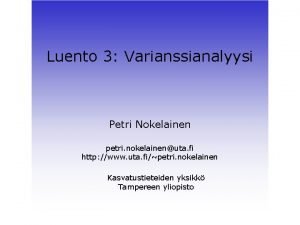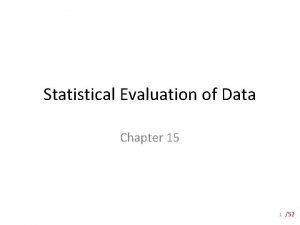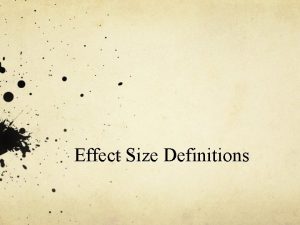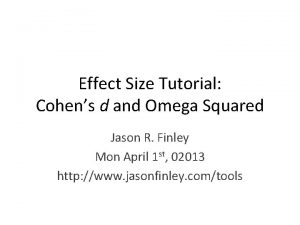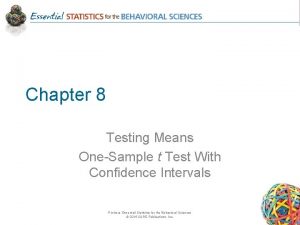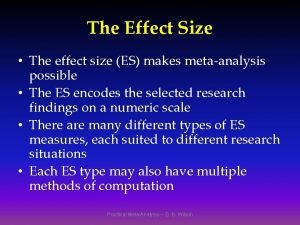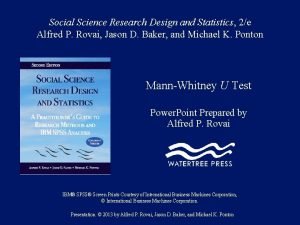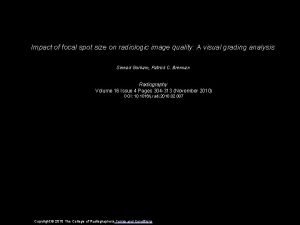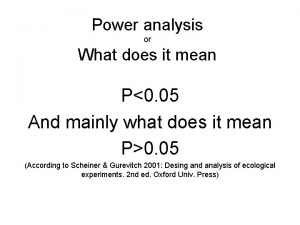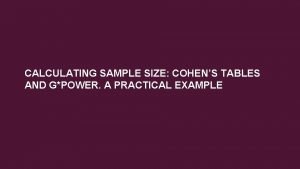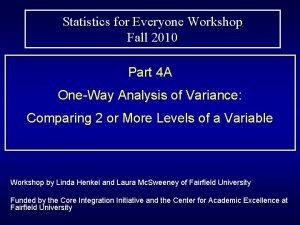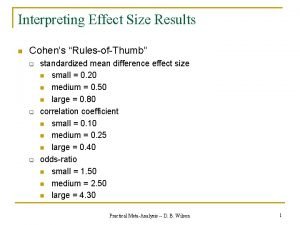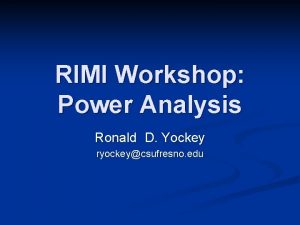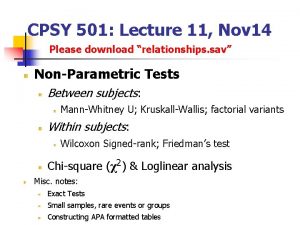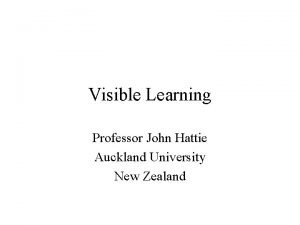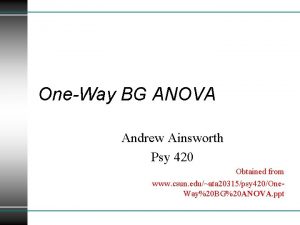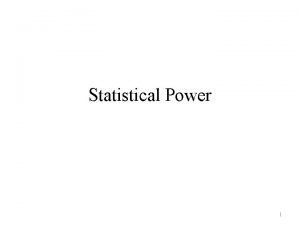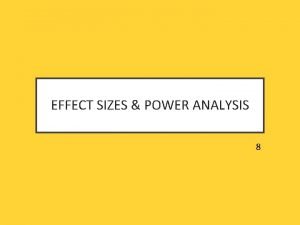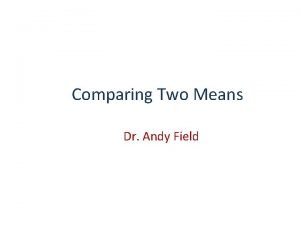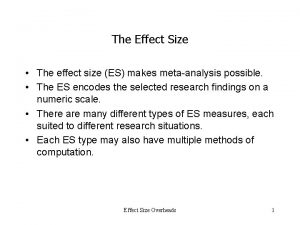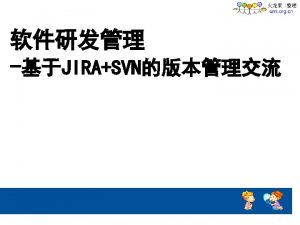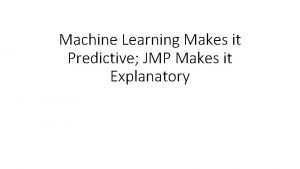The Effect Size The effect size ES makes




































- Slides: 36

The Effect Size • The effect size (ES) makes meta-analysis possible • The ES encodes the selected research findings on a numeric scale • There are many different types of ES measures, each suited to different research situations • Each ES type may also have multiple methods of computation Practical Meta-Analysis -- D. B. Wilson

Examples of Different Types of Effect Sizes (ES) • Standardized mean difference – Group contrast research • Treatment groups • Naturally occurring groups – Inherently continuous construct • Odds-ratio (OR) – Group contrast research • Treatment groups • Naturally occurring groups – Inherently dichotomous construct • Correlation coefficient – Association between variables research Practical Meta-Analysis -- D. B. Wilson

Examples of Different Types of Effect Sizes • Risk-ratio or Relative Risk (RR) – Group differences research (naturally occurring groups) – Commonly used by epidemiologist and medical meta-analyses – Inherently dichotomous construct – Easier to interpret than the odds-ratio (OR) – Does not overstate ES like OR does. Practical Meta-Analysis -- D. B. Wilson

Examples of Different Types of Effect Sizes • Proportion – Central tendency research • HIV/AIDS prevalence rates • Proportion of homeless persons found to be alcohol abusers • Standardized gain score – Gain or change between two measurement points on the same variable • Cholesterol level before and after completing a therapy • Others? Practical Meta-Analysis -- D. B. Wilson

What Makes Something an Effect Size for Meta-analytic Purposes • The type of ES must be comparable across the collection of studies of interest • This is generally accomplished through standardization • Must be able to calculate a standard error for that type of ES – The standard error is needed to calculate the ES weights, called inverse variance weights (more on this later) – All meta-analytic analyses are weighted “averages” (simple example on next slide) Practical Meta-Analysis -- D. B. Wilson

Weighted “Averages” Example: Calculating GPA’s Practical Meta-Analysis -- D. B. Wilson

Weighted “Averages” Example: Calculating GPA’s Practical Meta-Analysis -- D. B. Wilson

Weighted “Averages” Example: Calculating GPA’s Practical Meta-Analysis -- D. B. Wilson

Weighted “Averages” Example: Calculating GPA’s Practical Meta-Analysis -- D. B. Wilson

The Standardized Mean Difference • Represents a standardized group contrast on an inherently continuous measure • Uses the pooled standard deviation (some situations use control group standard deviation) • Commonly called “d” or occasionally “g” • Cohen’s d (see separate short lecture on Cohen’s d) Practical Meta-Analysis -- D. B. Wilson

The Correlation Coefficient (r) • Represents the strength of linear association between two inherently continuous measures • Generally reported directly as “r” (the Pearson product moment correlation) Practical Meta-Analysis -- D. B. Wilson

The Odds-Ratio (OR) • Recall, the odds-ratio is based on a 2 by 2 contingency table, such as the one below o o The Odds Ratio (OR) is the odds for “success” in the treatment group relative to the odds for “success” in the control group. OR’s can also come from results of logistic regression analysis, but these would difficult to use in a metaanalysis due to model differences. Practical Meta-Analysis -- D. B. Wilson

Relative Risk (RR) • The relative risk (RR) is also based on data from a 2 by 2 contingency table, and is the ratio of the probability of success (or failure) for each group Practical Meta-Analysis -- D. B. Wilson

Unstandardized Effect Size Metric • If you are synthesizing a research domain that using a common measure across studies, you may wish to use an effect size that is unstandardized, such as a simple mean difference. • Multi-site evaluations or evaluation contracted by a single granting agency. Practical Meta-Analysis -- D. B. Wilson

Effect Size Decision Tree for Group Differences Research (from Wilson & Lipsey) Practical Meta. Analysis - Wilson & Lipsey

Methods of Calculating the Standardized Mean Difference • The standardized mean difference probably has more methods of calculation than any other effect size type. Practical Meta-Analysis -- D. B. Wilson

Poor Good Great Degrees of Approximation to the ES Value Depending of Method of Computation – – Direct calculation based on means and standard deviations Algebraically equivalent formulas (t-test) Exact probability value for a t-test Approximations based on continuous data (correlation coefficient) – Estimates of the mean difference (adjusted means, regression b weight, gain score means) – Estimates of the pooled standard deviation (gain score standard deviation, one-way ANOVA with 3 or more groups, ANCOVA) – Approximations based on dichotomous data Practical Meta-Analysis -- D. B. Wilson

Methods of Calculating the Standardized Mean Difference (Independent Samples) Direction Calculation Method Practical Meta-Analysis -- D. B. Wilson

Methods of Calculating the Standardized Mean Difference (Independent Samples) Algebraically Equivalent Formulas: independent samples t-test two-group one-way ANOVA Exact p-values from a t-test or F-ratio can be converted into t-value and the above formula applied. Practical Meta-Analysis -- D. B. Wilson

Methods of Calculating the Standardized Mean Difference A study may report a grouped frequency distribution from which you can calculate means and standard deviations and apply to direct calculation method. Practical Meta-Analysis -- D. B. Wilson

Methods of Calculating the Standardized Mean Difference (Independent Samples) Close Approximation Based on Continuous Data: Point-Biserial Correlation - For example, the correlation between treatment/no treatment and outcome measured on a continuous scale. Point-Biserial Correlation: Pearson’s Product Moment Correlation (r) between the response (Y) and group indicator (X) coded as: Group 1 = 0, Group 2 = 1 and treated as a numeric variable. Practical Meta-Analysis -- D. B. Wilson

Methods of Calculating the Standardized Mean Difference (Independent Samples) Estimates of the Numerator of ES – The Mean Difference – difference between covariance adjusted means – unstandardized regression coefficient (b) for group membership Practical Meta-Analysis -- D. B. Wilson

Methods of Calculating the Standardized Mean Difference (Independent Samples, more than two groups) Estimates of the Denominator of ES Pooled Standard Deviation one-way ANOVA more than 2 groups

Methods of Calculating the Standardized Mean Difference SE = standard error of the mean the paired differences Paired difference between scores = gain scores Gain = pre-test – post-test (or vise versa) Practical Meta-Analysis -- D. B. Wilson

Methods of Calculating the Standardized Mean Difference Estimates of the Denominator of ES -Pooled Standard Deviation standard deviation of gain scores, where r is the correlation between pretest and posttest scores Practical Meta-Analysis -- D. B. Wilson

Methods of Calculating the Standardized Mean Difference Estimates of the Denominator of ES -Pooled Standard Deviation ANCOVA, where r is the correlation between the covariate and the dependent variable. Practical Meta-Analysis -- D. B. Wilson

Methods of Calculating the Standardized Mean Difference Estimates of the Denominator of ES -Pooled Standard Deviation A two-way factorial ANOVA where B is the irrelevant factor and AB is the interaction between the irrelevant factor and group membership (factor A). Practical Meta-Analysis -- D. B. Wilson

Methods of Calculating the Standardized Difference between Two Proportions Approximations Based on Dichotomous Data - the difference between the probits transformation of the proportion successful in each group - converts proportion into a z-value Practical Meta-Analysis -- D. B. Wilson

Methods of Calculating the Standardized Mean Difference Approximations Based on Dichotomous Data this represents the rescaling of the logged odds-ratio (see Sanchez-Meca et al 2004 Psychological Methods article) Practical Meta-Analysis -- D. B. Wilson 29

Methods of Calculating the Standardized Mean Difference Approximations Based on Dichotomous Data chi-square must be based on a 2 by 2 contingency table (i. e. , have only 1 df) phi coefficient Practical Meta-Analysis -- D. B. Wilson

Practical Meta-Analysis -- D. B. Wilson LINKED TO LECTURE SECTION OF COURSE WEBSITE

Practical Meta-Analysis -- D. B. Wilson

Formulas for the Correlation Coefficient (r) • Results typically reported directly as a correlation. • Any data for which you can calculate a standardized mean difference effect size, you can also calculate a correlation type effect size. Practical Meta-Analysis -- D. B. Wilson

Formulas for the Odds Ratio • Results typically reported in one of three forms: – Frequency of successes in each group – Proportion of successes in each group – 2 by 2 contingency table Practical Meta-Analysis -- D. B. Wilson

Data to Code Along With the ES • The effect size (ES) – – • • • May want to code the statistics from which the ES is calculated Confidence in ES calculation Method of calculation Any additional data needed for calculation of the inverse variance weight Sample size ES specific attrition Construct measured Point in time when variable measured Reliability of measure Type of statistical test used Practical Meta-Analysis -- D. B. Wilson

Issues in Coding Effect Sizes • Which formula to use when summary statistics are available for multiple formulas • Multiple documents/publications reporting the same data (not always in agreement) • How much guessing should be allowed – sample size is important but may not be presented for both groups – some numbers matter more than others Practical Meta-Analysis -- D. B. Wilson
![Const int size=18; string *tb12 = new string[size]; Const int size=18; string *tb12 = new string[size];](data:image/svg+xml,%3Csvg%20xmlns=%22http://www.w3.org/2000/svg%22%20viewBox=%220%200%20200%20200%22%3E%3C/svg%3E) Const int size=18; string *tb12 = new string[size];
Const int size=18; string *tb12 = new string[size]; Size separation objectives
Size separation objectives Varianssianalyysi
Varianssianalyysi Effect size meaning
Effect size meaning Cohen's d effect size criteria
Cohen's d effect size criteria Effect size hedges g
Effect size hedges g Cohen's d in spss
Cohen's d in spss Anova effect size
Anova effect size One sample t test effect size
One sample t test effect size Mean difference formula
Mean difference formula Parametric and nonparametric tests
Parametric and nonparametric tests Mann whitney u test effect size
Mann whitney u test effect size Effect of focal spot size on image quality
Effect of focal spot size on image quality Effect size statistics
Effect size statistics Relative effect size
Relative effect size Cohen sample size determination table
Cohen sample size determination table Effect size f small, medium large
Effect size f small, medium large Effect size q
Effect size q Jack baldermann westmont high school
Jack baldermann westmont high school Effect size f small, medium large
Effect size f small, medium large Wilcoxon test effect size
Wilcoxon test effect size Professor john hattie
Professor john hattie Effect size omega squared
Effect size omega squared Binomial effect size
Binomial effect size Cohen's d
Cohen's d Effect size scale
Effect size scale Power penelitian
Power penelitian Dependent ttest
Dependent ttest Effect size meaning
Effect size meaning Vẽ hình chiếu đứng bằng cạnh của vật thể
Vẽ hình chiếu đứng bằng cạnh của vật thể Phản ứng thế ankan
Phản ứng thế ankan Quá trình desamine hóa có thể tạo ra
Quá trình desamine hóa có thể tạo ra Các môn thể thao bắt đầu bằng từ đua
Các môn thể thao bắt đầu bằng từ đua Khi nào hổ mẹ dạy hổ con săn mồi
Khi nào hổ mẹ dạy hổ con săn mồi điện thế nghỉ
điện thế nghỉ Các loại đột biến cấu trúc nhiễm sắc thể
Các loại đột biến cấu trúc nhiễm sắc thể Nguyên nhân của sự mỏi cơ sinh 8
Nguyên nhân của sự mỏi cơ sinh 8
![Const int size=18; string *tb12 = new string[size]; Const int size=18; string *tb12 = new string[size];](https://slidetodoc.com/wp-content/uploads/2020/11/1588947_40cf3415d0afabae1c436a49b39f4ad0-300x225.jpg)

